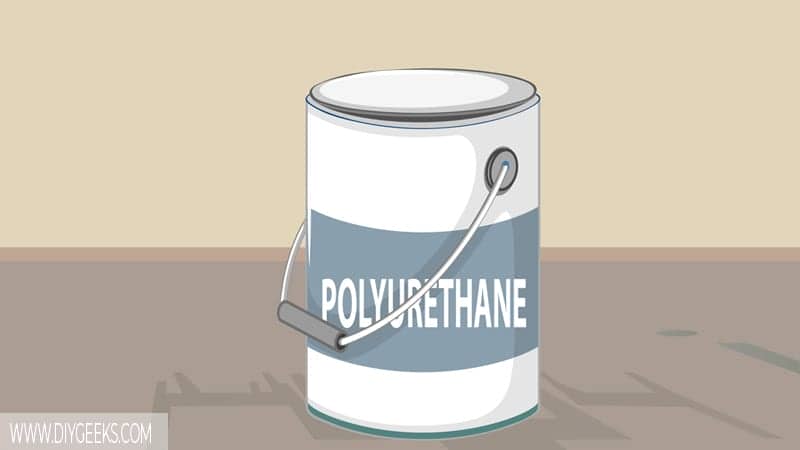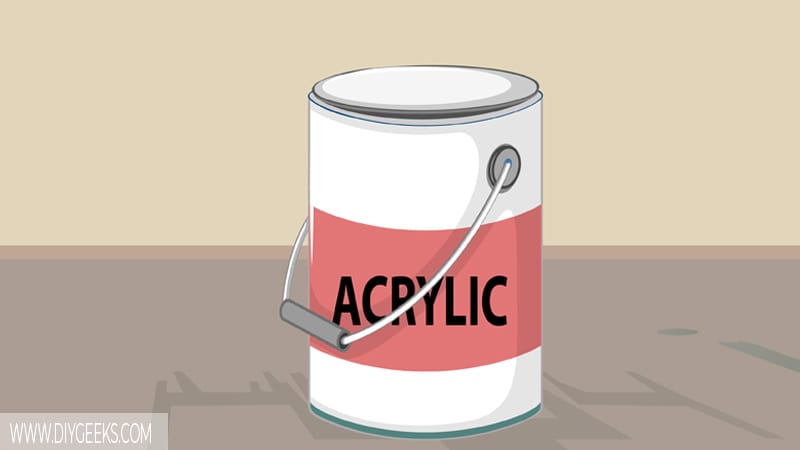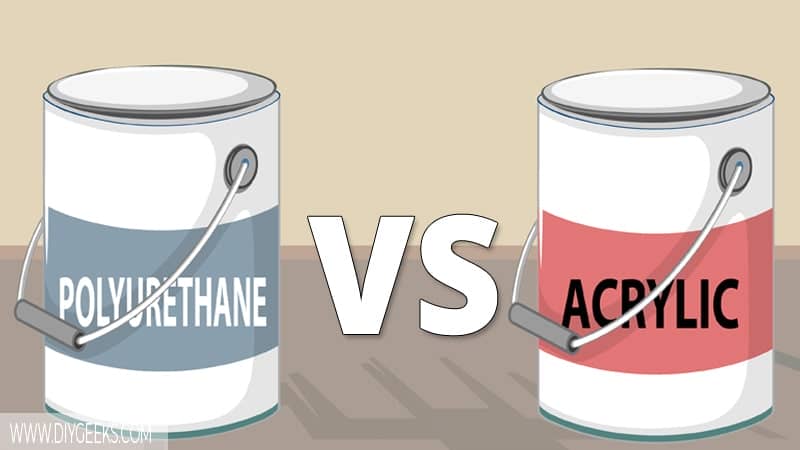Polyurethane is a protective sealer that forms a glossy moisture-resistant layer (barrier) over surfaces. Acrylic paint is a water-based finish that is known for its dry time, water-soluble finish, and colorful finish.
Polyurethane offers better moisture resistance, wood protection, and is easier to clean and maintain. Acrylic paint dries faster and produces a more colorful finish.
Polyurethane is a surface sealer and protector, while acrylic paint is a paint used to enhance and change the surface color shade.
What is Polyurethane?

Polyurethane is a protective sealer that protects and seals several surfaces from moisture, water, and scratches. It forms a glossy transparent finish that prevents water penetration.
There are two polyurethane types; oil-based and water-based. Both types have similar features, but their solvent difference makes them have different dry times and durability.
Oil-based polyurethane tends to yellow, while water-based poly retains its clear finish for years. There are also tinted polyurethanes that produce a glossy colorful finish that protects and seals several surfaces.
What is Acrylic Paint?

Acrylic paint is a water-based finish made from solvent (water), binders, and pigments. The paint is known for its fast-dry time and water-soluble finish.
You can use acrylic paint over several surfaces including wood, furniture, canvas, fabric, and paper. It’s a versatile paint and comes in different sheens including matte, satin, and glossy.
Acrylic paint doesn’t have protective additives and shouldn’t be applied over exterior surfaces as the paint is water-soluble and will get removed if exposed to constant water.
Polyurethane vs Acrylic Paint
The differences between polyurethane and acrylic paint are listed below.
The Formula and Solvent
Polyurethane comes in a water-based and oil-based formula that contains a high urethane amount, solvents, and resins. Acrylic paint has a water-based formula that contains the solvent (water), binder, and pigments (or colorants).
The Dry Time
Polyurethane takes longer to dry than acrylic paint as it has extra protective additives that take longer to evaporate. Water-based polyurethane takes between 6-8 hours to dry between coats, while acrylic paint takes between 30-60 minutes.
Moisture Resistance
Polyurethane offers better moisture resistance than acrylic paint as it has extra protective additives and forms a glossy plastic-like finish that prevents moisture penetration.
Acrylic paint isn’t moisture-resistant and can get removed if exposed to constant water or moisture.
Wood Protection
Polyurethane offers better wood protection than acrylic paint because it forms a glossy moisture-resistant finish that prevents water penetration. Exterior polyurethane protects surfaces from weather elements too.
Acrylic paint offers low wood protection as its finish is water-soluble and will get damaged (or removed) if exposed to constant water.
The Finish Type
Polyurethane forms a glossy transparent (colorless) finish, while acrylic paint forms a dry textured colorful finish.
Polyurethane forms a glossy transparent finish that reflects light and reveals the underlying surface. Its finish doesn’t affect the underlying surface color shade or appearance.
Acrylic paint forms a dry textured colorful finish that fully covers the underlying surface as it’s formulated with a high pigment amount.
Purpose and Usage
The polyurethane purpose is to seal and protect the underlying surface from moisture, water, scratches, and weather elements. It’s used for interior and exterior surfaces, including floors.
The acrylic paint purpose is to add color to interior surfaces, enhance the appearance, and offer low surface protection. The paint makes interior surfaces appear better and more colorful.
Don’t use acrylic paint outdoors as the paint isn’t durable enough to withstand weather elements and will get removed if exposed to constant water or rainfall. You must seal the paint with a sealer to improve its outdoor durability.
Cleaning and Maintenance
Polyurethane is easier to clean and maintain than acrylic paint because its glossy finish doesn’t attract dust or filth, and you can use a liquid-based cleaner to clean it without damaging the finish.
Acrylic paint is harder to clean or maintain as its dry textured finish attracts more dust or filth, so you must clean it more often. You can’t use a strong liquid-based cleaner to clean the paint finish as it can remove it.
Which Finish Do You Need?
Here are a few factors to consider when choosing between these two finishes:
- Budget: Use acrylic paint if you have a low budget.
- Finish: Use polyurethane if you want a glossy transparent finish, and use acrylic paint if you want a dry textured colorful finish.
- Protection: Use polyurethane if you want to protect surfaces from moisture, water, scratches, and weather elements.
- Surface Type: Use acrylic paint for interior surfaces and polyurethane for exterior surfaces.
- Cleaning: Use polyurethane if you want a finish that’s easier to clean and maintain as its glossy finish doesn’t attract dust or dirt.
- Durability: Use polyurethane if you want a durable finish that can last longer.


